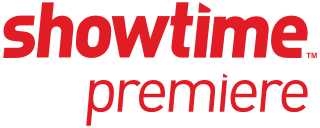
Television broadcasting in Australia began officially on 16 September 1956, with the opening of TCN-9, quickly followed by national and commercial stations in Sydney and Melbourne, all these being in 625-line black and white. The commencement date was designed so as to provide coverage of the Olympic Games in Melbourne. It has now grown to be a nationwide system that includes a broad range of public, commercial, community, subscription, narrowcast, and amateur stations.
Foxtel is an Australian pay television company—operating in cable television, direct broadcast satellite television, and IPTV streaming services. It was formed in April 2018, superseding an earlier company from 1995. The service was established as a 50/50 joint venture between News Corporation and Telstra, with News Corp and Telstra holding 65% and 35% ownership shares respectively.
Optus Television is the cable television division of Australian telecommunications company Optus.
Pay television, also known as subscription television, premium television or, when referring to an individual service, a premium channel, refers to subscription-based television services, usually provided by multichannel television providers, but also increasingly via digital terrestrial, and streaming television. In the United States, subscription television began in the late 1970s and early 1980s in the form of encrypted analog over-the-air broadcast television which could be decrypted with special equipment. The concept rapidly expanded through the multi-channel transition and into the post-network era. Other parts of the world beyond the United States, such as France and Latin America have also offered encrypted analog terrestrial signals available for subscription.

MTV is a 24-hour general entertainment channel specialising in music and youth culture programming which serves Australia and New Zealand. It is operated by parent company Paramount Networks UK & Australia headquartered in London with a local office at Network 10's headquarters in Sydney.

Television in Australia began experimentally as early as 1929 in Melbourne with radio stations 3DB and 3UZ, and 2UE in Sydney, using the Radiovision system by Gilbert Miles and Donald McDonald, and later from other locations, such as Brisbane in 1934.

Showtime Movie Channels is a group of Australian pay-TV movie channels, available on the Foxtel, Optus and Austar TV platforms. The service consisted of five original channels, three HD simulcasts and two timeshift channels. It was owned and operated by the Premium Movie Partnership (PMP), a joint venture in which Sony Pictures Entertainment, NBCUniversal, Viacom, News Corporation and Liberty Global had equal shares. Foxtel took over managing and producing the Showtime channels as of 31 October 2012, with it purchasing assets of the PMP. On 9 December 2012, it was announced that Movie Network and Showtime would be replaced with a new line-up of Foxtel branded movie channels to be named Foxtel Movies

The Ovation Channel was created by Optus Television to "present dance, opera, theatre, literature, jazz, classical music, design and even fashion, food and wine", modelling it on Canada's Bravo!, which formerly focused on such programming.

KWHY-TV is a Spanish-language independent television station licensed to Los Angeles, California, United States. Owned by Meruelo Broadcasting, it is part of a duopoly with Garden Grove-licensed KBEH ; the two stations share channel 4 under a channel sharing agreement. KWHY and KBEH share studios on West Pico Boulevard in the Mid-City section of Los Angeles and transmitter facilities atop Mount Wilson.
Subscription television in Australia is provided using technologies such as cable television, satellite television and internet television by a number of companies unified in their provision of a subscription television service. Notable actors in the sector include Foxtel, Netflix and Stan. Regulation of the sector is assured by the Australian Communications and Media Authority.

Galaxy is a former provider of pay television programming in Australia via satellite and wireless cable (microwave) delivery methods.

Disney Channel was an Australian pay television channel. It was the flagship television property owned and operated by The Walt Disney Company in Australia. Launched in 1996, the network targeted towards children and their families, with original series and movies.

SelecTV was an American subscription television service that was formed in 1976 and first began broadcasting in 1978; the service focused entirely on televising movies, and was shut down in 1989.
The ASTRA Awards were the annual awards for the Australian subscription television industry. According to the Australian Subscription Television and Radio Association (ASTRA), the awards "recognise the wealth of talent that drives the Australian subscription television industry and highlight the creativity, commitment and investment in production and broadcasting.".
Internet television in Australia is the digital distribution of movies and television content via the Internet. In Australia, internet television is provided by a number of generalist, subscription-based streaming service providers, in addition to several niche providers that focus on specific genres. Australia's five major free-to-air television networks also all offer catch up TV of previously broadcast content to watch via their webpages and apps, and a number of ISPs and other companies offer IPTV – the live streaming of television channels sourced from Australia and elsewhere.

Movie Network Channels was an Australian premium television movie service that consisted of five original channels, two SD timeshifts and three HD simulcasts. Its main competitor was Showtime. Movie Network channels were originally only available through Optus TV, who produced and part-owned the channels prior to 1 January 2000.

Presto was an Australian media streaming company which offered subscriptions to unlimited viewing of selected films, and from 2015, TV series. The service, initially owned wholly by Foxtel, launched on 13 March 2014 featuring films exclusively.

Kayo Sports is an over-the-top video streaming subscription service available in Australia, owned by Streamotion. The service offers sports live and on demand from Fox Sports, ESPN, beIN Sports, and Racing.com.

Binge is a video streaming subscription service available in Australia, owned by Streamotion. The service offers on demand and live entertainment, lifestyle, reality and movie programming.













